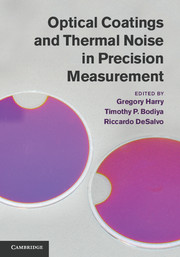Book contents
- Frontmatter
- Contents
- List of contributors
- Foreword
- Preface
- 1 Theory of thermal noise in optical mirrors
- 2 Coating technology
- 3 Compendium of thermal noises in optical mirrors
- 4 Coating thermal noise
- 5 Direct measurements of coating thermal noise
- 6 Methods of improving thermal noise
- 7 Substrate thermal noise
- 8 Cryogenics
- 9 Thermo-optic noise
- 10 Absorption and thermal issues
- 11 Optical scatter
- 12 Reflectivity and thickness optimization
- 13 Beam shaping
- 14 Gravitational wave detection
- 15 High-precision laser stabilization via optical cavities
- 16 Quantum optomechanics
- 17 Cavity quantum electrodynamics
- References
Foreword
Published online by Cambridge University Press: 05 January 2012
- Frontmatter
- Contents
- List of contributors
- Foreword
- Preface
- 1 Theory of thermal noise in optical mirrors
- 2 Coating technology
- 3 Compendium of thermal noises in optical mirrors
- 4 Coating thermal noise
- 5 Direct measurements of coating thermal noise
- 6 Methods of improving thermal noise
- 7 Substrate thermal noise
- 8 Cryogenics
- 9 Thermo-optic noise
- 10 Absorption and thermal issues
- 11 Optical scatter
- 12 Reflectivity and thickness optimization
- 13 Beam shaping
- 14 Gravitational wave detection
- 15 High-precision laser stabilization via optical cavities
- 16 Quantum optomechanics
- 17 Cavity quantum electrodynamics
- References
Summary
As Lord Kelvin was renowned for saying – “to measure is to know” – and indeed precision measurement is one of the most challenging and fundamentally important areas of experimental physics.
Over the past century technology has advanced to a level where limitations to precision measurement systems due to thermal and quantum effects are becoming increasingly important. We see this in experiments to test aspects of relativity, the development of more precise clocks, the measurement of the Gravitational Constant, experiments to set limits on the polarisation of the vacuum, and the ground based instruments developed to search for gravitational radiation.
Many of these experimental areas use laser interferometry with resonant optical cavities as short term length or frequency references, and thermal fluctuations of cavity length present a real limitation to performance. This has received particular attention from the community working on the upgrades to the long baseline gravitational wave detectors, LIGO, Virgo and GEO 600, the signals from all likely sources being at a level where very high strain sensitivity – of the order of one part in 1023 over relevant timescales – is required to allow a full range of observations. Research towards achieving such levels of strain measurement has shown that the thermal fluctuations in the length of a well designed resonant cavity are currently dominated by those due to mechanical losses in the dielectric materials used to form the multi-layer mirror coating used, with the fluctuations of the mirror substrate materials also playing an important part.
- Type
- Chapter
- Information
- Optical Coatings and Thermal Noise in Precision Measurement , pp. xi - xiiPublisher: Cambridge University PressPrint publication year: 2012



